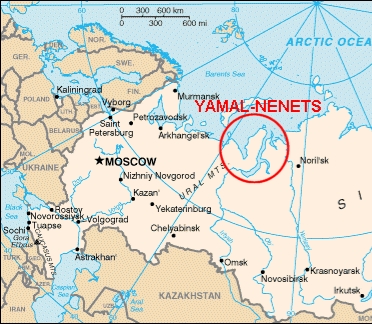The Yamal Peninsula (Russian: полуо́стров Яма́л) is located in the Yamalo-Nenets Autonomous Okrug of northwest Siberia, Russia. It extends roughly 700 km (435 mi) and is bordered principally by the Kara Sea, Baydaratskaya Bay on the west, and by the Gulf of Ob on the east. At the northern end of this peninsula lies the Malygina Strait and, beyond it, Bely Island. In the language of its indigenous inhabitants, the Nenets, “Yamal” means “End of the Land”.
The peninsula consists mostly of permafrost ground and is geologically a very young place —some areas are less than ten thousand years old.[citation needed]
Yamal is inhabited by a multitude of migratory bird species.
The well-preserved remains of Lyuba, a 37,000-year-old mammoth calf, were found by a reindeer herder on the peninsula in the summer of 2007. The animal was female and was determined to be one month old[1] at the time of death.[2][3]
On 21 October 2016 a Russian Mi-8 helicopter carrying oil and gas workers crashed there, killing at least 19 of the 22 people on board.[4]
According to Sven Haakanson, within the Russian Federation, the Yamal peninsula is the place where traditional large-scale nomadic reindeer husbandry is best preserved.[5][6] Nenets and Khanty reindeer herders hold about half a million domestic reindeer.
The area is largely undeveloped, but work is ongoing with several large infrastructure projects including a gas pipeline, and several bridges.[7] Yamal holds Russia’s biggest natural gas reserves.[8] The 572 km Obskaya–Bovanenkovo railway, completed in 2011, is the northernmost railway in the world.[9] Russian gas monopolist Gazprom had planned to develop the Yurkharovskoye gas field by 2011–2012. Peninsula’s gas reserves estimated to be 55 trillion cubic meters (tcm).[7] Russia’s largest energy project in history, known as the Yamal project, puts the future of nomadic reindeer herding at considerable risk.[citation needed]
